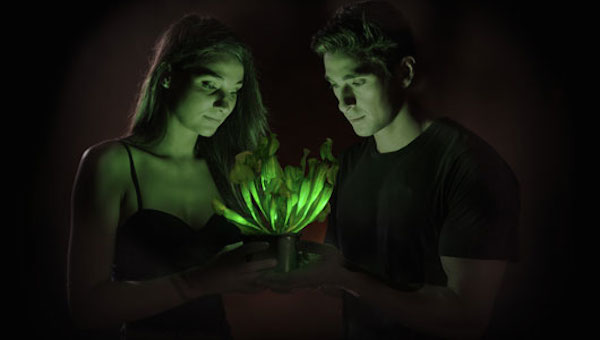
The company Bioglow has successfully developed a plant that produces light in a completely natural process that requires no chemicals or electricity. These kinds of glowing plants were invented by molecular biologist, Dr. Alex Krichevsky and they are the result of his research into bioluminescent marine bacteria and the molecular biology of plants. Bioglow’s Starlight Avatar, as it is called, is the first light producing plant in the world, and it could become a sustainable replacement for traditional, electric lighting.
The Starlight Avatar plants have been genetically modified through the process of adding the light-emitting pathway from marine bacteria into plant’s chloroplast genome. These plants can produce light on their own, without need for chemical additives or UV light. The Starlight Avatar emits light that is comparable in strength to starlight. It is best viewed in complete darkness, and after allowing your eyes to adjust to poor light. In other words, the plant’s light emitting abilities are very poor, but the company is striving to develop a more powerful plant that could serve as a light source that could replace electrical powered lights.
The Starlight Avatar, which can be ordered online, arrives in a specially designed see-through plastic cultivation box where it grows on a nutrient-rich gel. Once it fills the entire container it can be replanted into a regular pot. The optimal conditions for this plant to grow are temperatures of 75-80F and light intensity of 5,000-10,000 lux, which is roughly a third of the intensity of direct sunlight. In carefully controlled conditions the plant will survive for about three months.

While using plants as light sources sounds like a great idea, this currently available type of plant is very fragile. The Starlight Avatar will not survive for more than a few days in direct sunlight, and it is also very unlikely to survive in an outdoor garden, since it is very susceptible to a number of abiotic conditions, including water shock.
Krichevsky is, however confident that with further study and development, glowing plants could one day have many practical uses. He believes they could be used to mark the sides of driveways or even highways. This would successfully reduce the need for electrical lighting and therefore the use of fossil fuels. The plants could also be used as backup lighting sources, and could, conceivably, be planted to form a glowing lawn for airports, or serve the leisure industry in resorts and on golf courses.
Related Articles on JetsonGreen.com:
Bright Beads Pendant Lights Showcase Sustainable Design for LED and EE Lighting
Edison-Inspired LED Lamp is Energy-Efficient Replacement for Incandescents
New LED Lighting Styles Launched by Barn Light Electric

Leave a Reply
You must be logged in to post a comment.